Among the most requested and offered products of these pandemic months there are, in addition to the classic masks, hand disinfectants and infrared thermometers, also UV-C lamps.
Just take a look on Amazon, which usually represents very well in trends in terms of interest in a product, to realize that there is a huge offer around this specific niche.
Quantity does not always go hand in hand with quality, so that accessories of mysterious, ineffective, or even dangerous brands proliferate. This is all the more true in the case of UV-C devices which, due to their peculiarity, can be very useful if used in specific contexts and precise methods, if misused they can represent a real risk for the skin and eyes.
Presenting, as we are about to do, two UV-C lamps like those of 59S that we have chosen for a test, must start from these premises.
We anticipate that the two products are on sale on Amazon and at a discount thanks to some dedicated coupons: the 59s bag can be purchased at the price of 118.99 euros on Amazon by clicking on this direct link and applying the discount code P55IT30OFF .
The 59s wand can be purchased at the price of 90.99 euros on Amazon by clicking on this direct link and applying the discount code X5IT30OFF01 .
UV lamps and UVC lamps
Our test of the UV-C lamps produced by 59s started from a fundamental premise: this note from the Ministry of Health, which in turn represents a synthesis of a much more structured document drawn up by the Istituto Superiore della Sanità which explains how to sanitize during the COVID-19 emergency, in a non-sanitary environment, surfaces, interiors and clothing.
Given that UV-C radiation, as also demonstrated by a study by a group of Italian researchers, published in preprint on the Medrxiv platform (and made understandable by all from this note by Adn Kronos) has “excellent efficacy in neutralizing the Coronavirus SARS -CoV-2 “, it is equally true that the same rays can represent a serious health risk” due to dosages of UV-A, UV-B, UV-C rays that do not comply with European standards.
Even if we talk mainly about erythema and conjunctival irritation and therefore transient damage, we should not underestimate the fact that UV radiation in the long run can expose to an increased risk of skin cancer.
In addition to this, there is also the presence on the market, as appears from the RAPEX report of 10 July (Community rapid information system on non-food products), of “various products that do not emit UV-C radiation,” products which consequently, they may not kill bacteria or viruses which, therefore, could reach the user, increasing the risk of infection “
Finding on Amazon products that comply with these standards, in particular UV-C emission, which have obtained a CE certification, manufactured products by unknown companies is not easy. However, some of these are there; in the end, as mentioned, we focused on two 59S products: a UV-C wand and a sterilization container. You see them below
Why the 59s test
As we have explained, on Amazon there are many products capable (or promising) of emitting UV-C rays, but among the many, few have a tradition and credibility in this area comparable to 59S.
Shenzhen UVLED Optical Technology Co, this is the formal name of 59s, is a Chinese company that has been operating on the international market for years with a specific specialization in the field of UV-C lamps and is currently the largest producer in the world in this sector: the 50 % of the world's UV LEDs come out of this company's factories.
The UV-C LED lamps, certified by a long series of government bodies (in addition to CE also SGS, FDA, EPA) and the actual devices have been presented at various health sector fairs and adopted by medical facilities and hospitals long before that the pandemic spread, generating interest in this particular type of lamp.
The LEDs used (also sold by other companies in the sector) are produced in house and do not generate ozone, another of the risks of UV-C lamps. According to what the manufacturer reports, specifically questioned by us on the matter, they also have the EN62471 certification which guarantees the photobiological safety of LED lamps.
It is for this reason that 59S products are on sale in many Italian stores, including large chains. These stores are constantly subjected to checks by the authorities and having an Italian company name (as well as a credibility to defend) as opposed to some unscrupulous e-commerce because based in unlikely countries, they cannot afford the risk of providing customers who are not certified or, worse, dangerous devices.
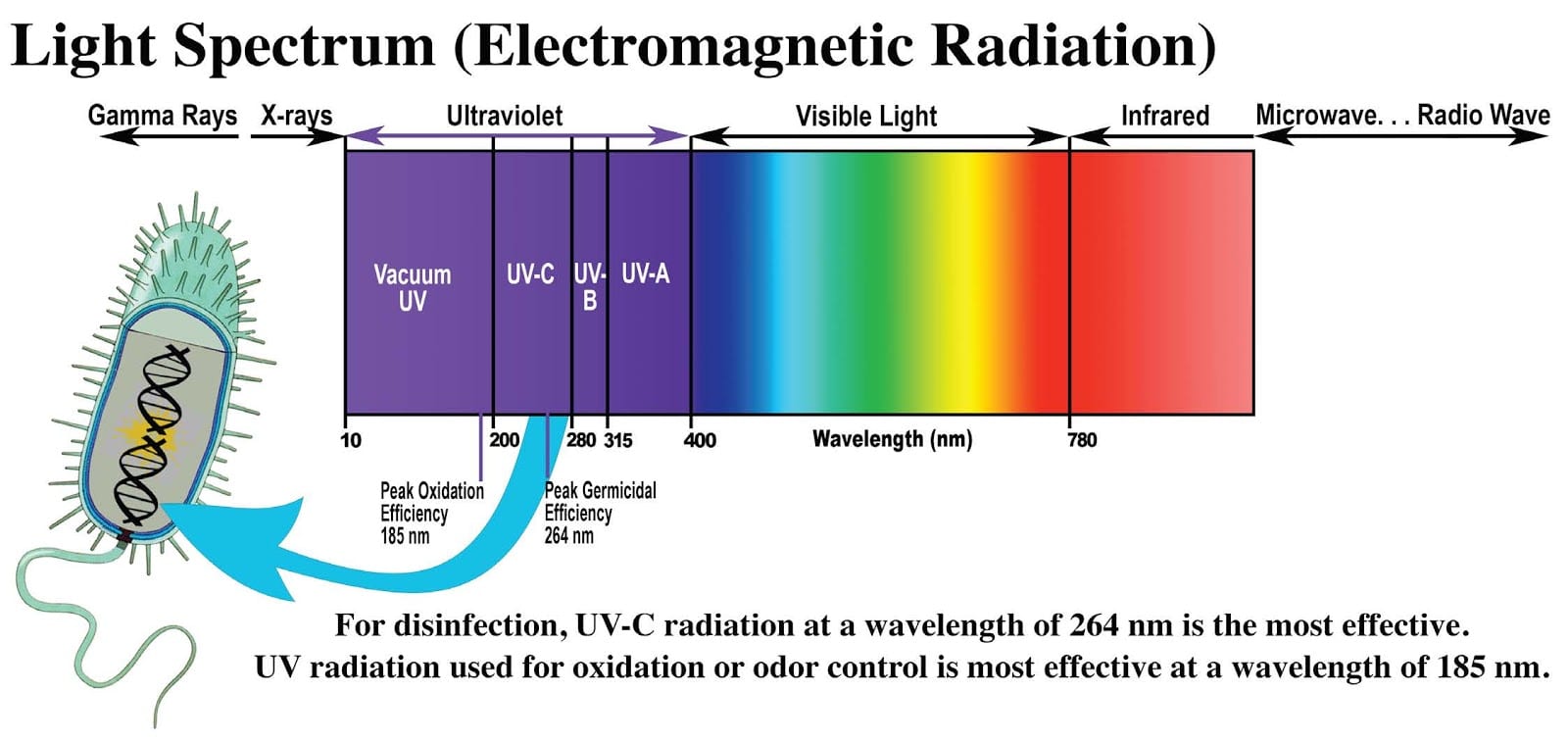
How 59S UV-C lamps work
How do 59S UV-C lamps work? The answer lies in the controlled emission of ultraviolet radiation which, at a given wavelength, is capable of rendering a virus or bacterium harmless.
We will not go into excessive detail, firstly because this is not the place nor is it an element of specific interest, secondly because Cyberlayman has already explained several things in this article, and then, above all, because not being a scientist we would simply risk repeat what you can read elsewhere.
In summary we can say that 59S UV-C lamps exploit the antibacterial power of ultraviolet (UV) light; in band C, with a length between 280 and 200 nanometers, the radiation is able to break the molecular bonds of DNA and RNA, inactivating or killing bacteria, viruses, spores, fungi, molds and mites.
Tests on the ability of UV-C to destroy COVID-19 have not yet been completed, but the preliminary results are very comforting and indirectly confirmed by the fact that it is proven that other Coronaviruses, absolutely close relatives of COVIOD-19, such as SARSCoV-1 (cause of SARS) and MERS-CoV (causing MERS) are destroyed by UV-C lamps.
Using 59s UV-C lamps
Using a UV-C lamp, such as those of 59s, can be interesting for various purposes. Thanks to its virucidal and bactericidal power, we can imagine using a similar lamp to regenerate the masks, to secure bunches of keys, money, smartphones, objects such as ballpoint pens or notepads, sheets of paper, documents, keyboards, mice and in general any object that has been handled by other people and cannot be disinfected in an alternative way.
To deal with most of the sterilization problems we have decided to examine two different products part of the 59S “home series”: P55 Pro, a bag closed by a zip, and the foldable and “pocket” UV ray wand.
Two products for two different uses
The bag and the wand have different uses. The bag has a decent size and is a good system for sterilizing multi-sided objects; for example, a mobile phone, a credit card, scissors, tweezers, small tools (a screwdriver, pliers …) a bunch of keys, a remote control or a pen.
The wand is intended for larger surfaces which substantially have only one face or which cannot in any case be inserted into the bag; we could imagine using it to treat a small desk, keyboard, telephone, book cover, faucet and so on.
Being foldable, the wand can be slipped into a bag and easily carried with you even during a trip and used to sterilize items that are in a hotel room and which you suspect have not been sanitized properly.
The P55 Pro Bag as it is made
The P55 Pro bag was the first device we tested. It is a miniature home derivative of some devices that are seen in hospitals, testing laboratories or beauticians. It is made of a good quality plastic, sewn and equipped with a handle and with a sturdy Zip zip that serves to close it.
Inside we find tabs that go down over the edge of the lid for greater safety; one of these tabs contains a magnet that also functions as an emergency switch: when the lid is opened, the lamps go out. On the front we also have a small slit with a blurred plastic to check if the LEDs are on.
Inside we find two LED beds for a total of 24 lamps. Always inside we find a coating in reflective material to spread UV-C radiation evenly. A grid supports the objects by detaching them from the bottom so as to make their backs “visible” to the light.
The P55 Pro bag must be powered constantly (it does not have an internal battery); the connection is located on the back of the bag itself, drowned in plastic. Once plugged in, the light does not start immediately; in fact, to sterilize the objects, you must press a button on the front.
1 of 11 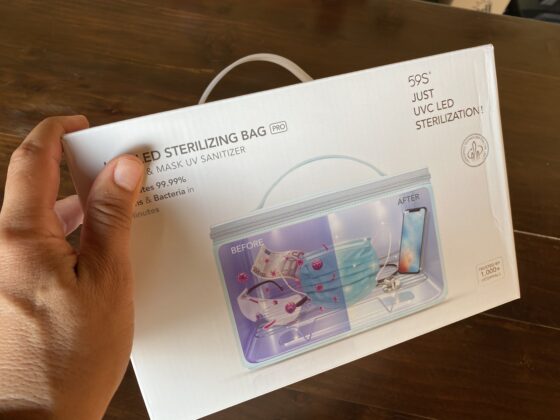 The P55 box, the UV-C sterilization bag
The P55 box, the UV-C sterilization bag 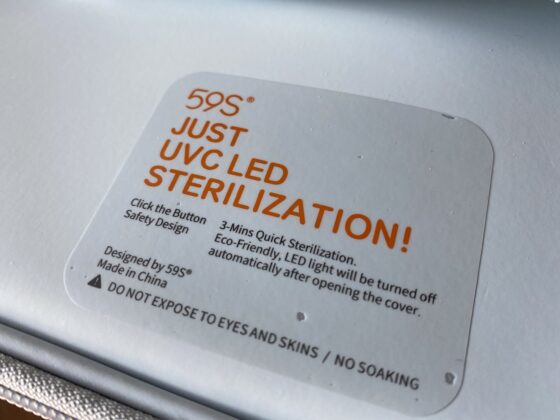 The safety information
The safety information 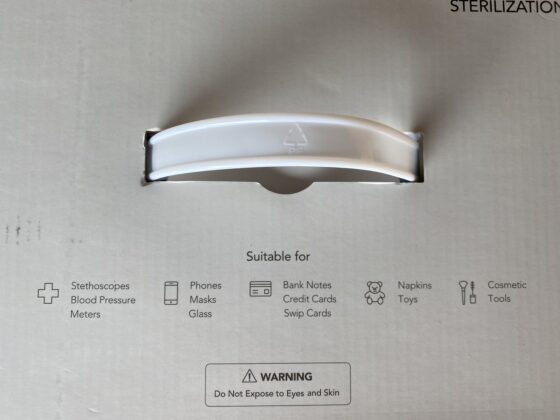 Advice on use
Advice on use 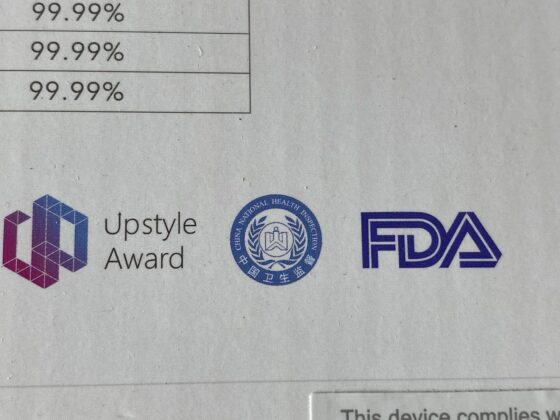 Some of the safety certifications obtained. The one of the FDA stands out, the American agency that also deals with medical devices
Some of the safety certifications obtained. The one of the FDA stands out, the American agency that also deals with medical devices 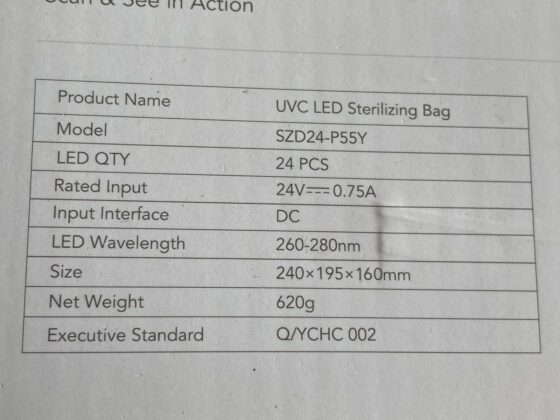 In “plate” data
In “plate” data 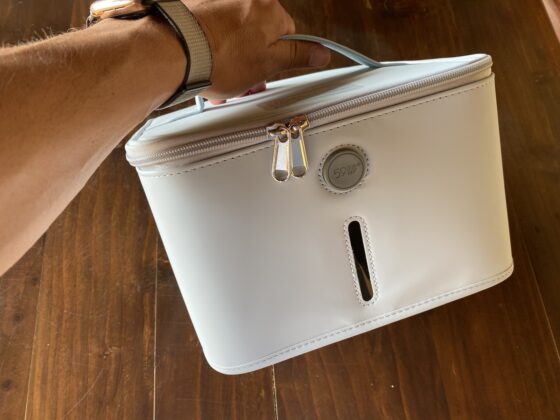 The UV-C bag seen from outside
The UV-C bag seen from outside 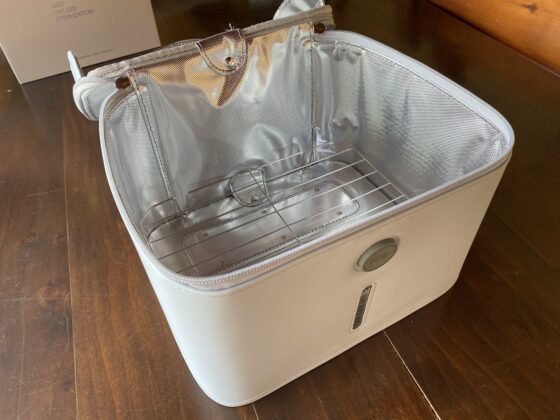 The P55 bag open
The P55 bag open 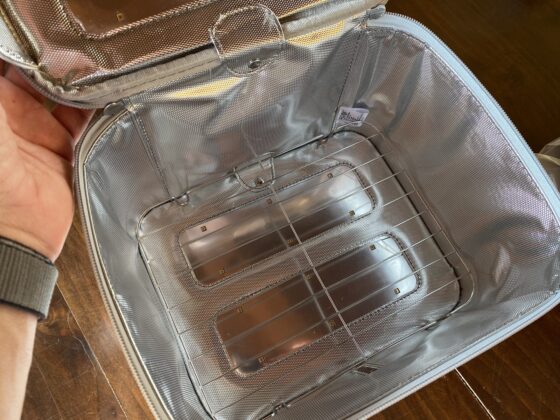 Here is the reflective interior
Here is the reflective interior 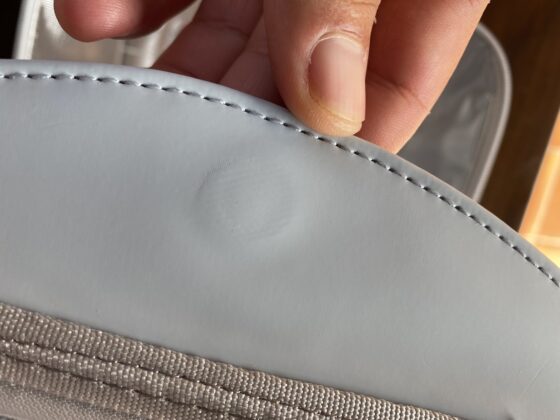 The magnet that turns the lamp on and off
The magnet that turns the lamp on and off 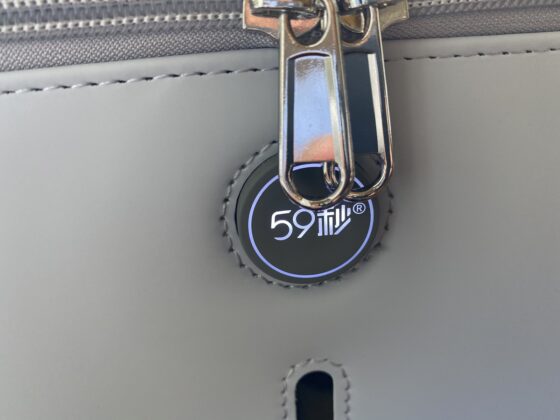 The power button
The power button 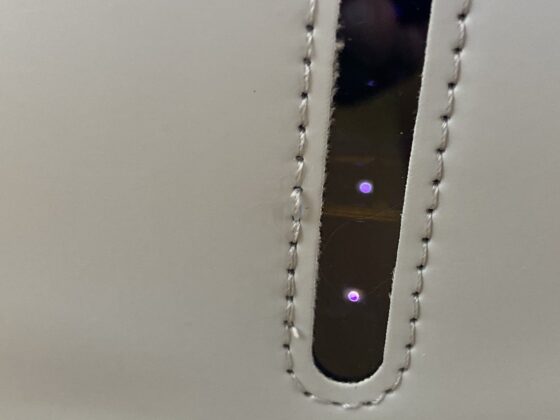
Useful for masks and small objects
The bag, as mentioned, has a fair size (25 X 20 X 15) sufficient for its purpose: to be a home or work sterilization system for small objects. Ideally in a home we see the P55 Pro as an excellent system to regenerate masks or gloves.
Since some devices, such as keys or telephones, are of very personal use, the need to sanitize them only intervenes if they have been used by other people, but in this case the bag becomes useful. Those who are particularly anxious can also use it to “secure” credit cards or banknotes.
In a professional scenario this bag could be placed on a shop desk to handle items that come from customers; just think of a laboratory that carries out small repairs. The P55 pro can also be used by a barber or a beautician and so on; even if for these categories there are professional equipment, the 59s bag has the advantage of having a reduced cost.
1 of 2 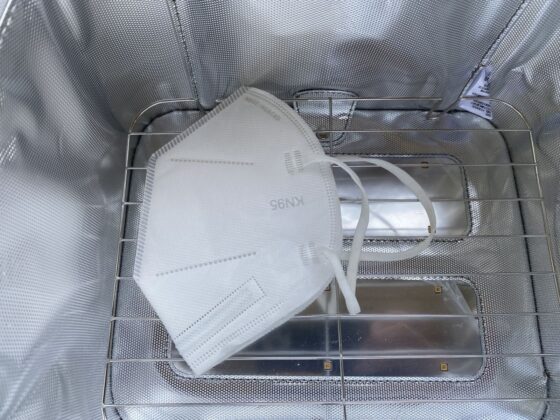 It is particularly suitable for disinfection and regeneration of masks
It is particularly suitable for disinfection and regeneration of masks 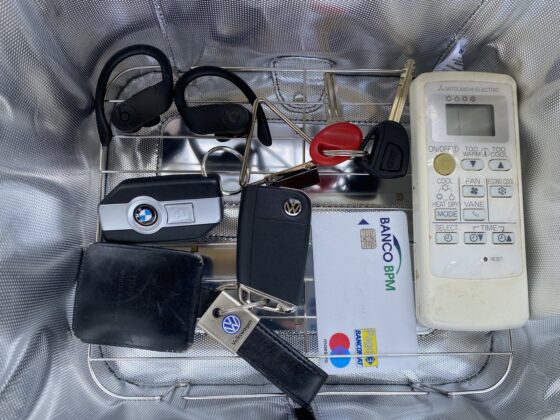 Usage ideas …
Usage ideas …
For food
Obviously you could also use the bag for other purposes such as sterilizing a bottle or treating or packaging of food and foods for which UV-C rays are harmless and can extend their duration over time even without resorting to the fridge, killing fungi, molds and spores.
In addition, it is proven that UV-C rays totally eliminate E. coli, Salmonella, Listeria and other pathogens of food origin; for this they are a safe and proven way to extend the shelf life of food and drinks. In fact, UV-C lamps are used by food producers and chains d and food.
In this case the only limit is represented by the size; you can't put big things inside the bag: at most a fruit, a sandwich, a toast. All obviously without packaging since plastic acts as a shielding factor, largely blocking the effectiveness of UV-C rays.
P55 Pro, how it works
The operation of the bag is very simple. It opens, the objects are placed inside (beware of those that are too small, the grill has rather large openings and could fall to the bottom), closes the zipper and turns on. After three minutes the sterilization will be automatically finished and the LED lamps off.
If by any chance you suddenly need one of the items while you are sterilizing, or you are distracted, the bag turns off the LEDs if the lid is lifted. Security is therefore guaranteed. During our test the P55 Pro did not exhibit any heating problems; externally it is cold. The objects inside, even if they have just been extracted, are only modestly lukewarm
From an ergonomic point of view, there is little to say; takes up little space, can be easily transported and handled. It is also very light (half KG).
The 59s UVC wand
An alternative device to the bag is the UV-C ray wand. It is a system designed to be placed inside a bag and carried around; it is foldable and lightweight and contains a rechargeable battery. The materials, as for the bag, seem of excellent quality and even the engineering has been well taken care of for its purpose.
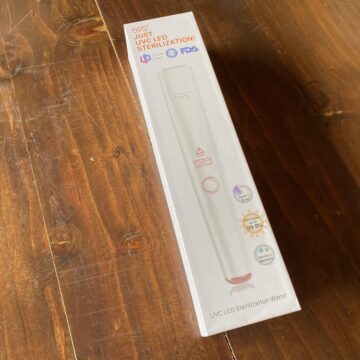 The 59s wand packaging
The 59s wand packaging 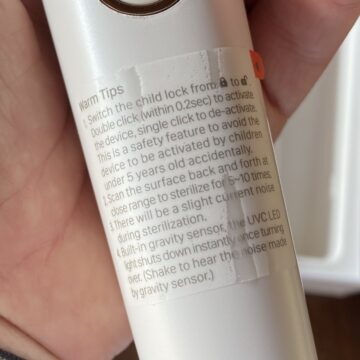 Safety Warnings
Safety Warnings 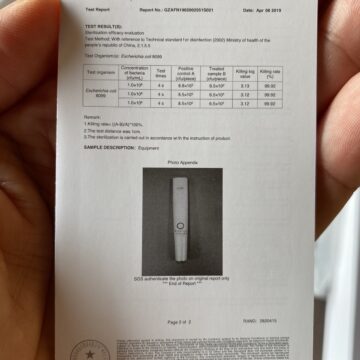 The SGS Germicidal and Bactericidal Report
The SGS Germicidal and Bactericidal Report 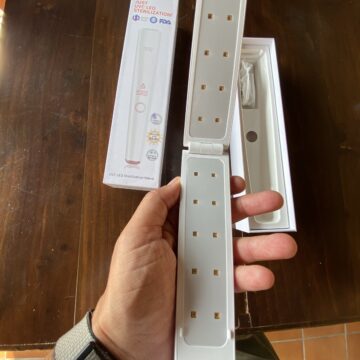 The LEDs that determined the disinfectant action
The LEDs that determined the disinfectant action 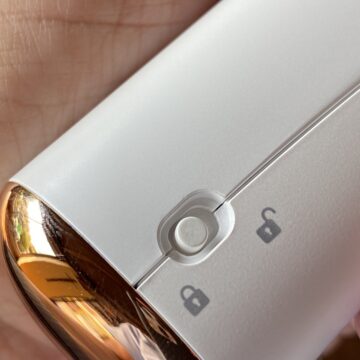 The safety switch
The safety switch  The power button
The power button
Sanitation away from home
As mentioned, the 59s wand is a tool essentially meant for sterilizing objects and surfaces when away from home. The manufacturer shows, by way of example, the treatment of objects in a hotel, the keys of an elevator, car seats.
In reality, it seems to us that for cases like these it is more appropriate to proceed with disposable gloves or by appropriate disinfection of the hands. It does not seem too practical to use the button of an elevator for three minutes and it is not socially acceptable to pass the wand for the same time on a train seat or perhaps on a restaurant chair.
Instead, it seems to us that it can be interesting if you want to sterilize computer keyboards or a mouse used by the public, or an object that we could not put inside the P55 Pro bag. Let's see how disinfection is also possible for those who have particular needs and concerns. a mattress or sheets in a hotel or perhaps a toilet in a public place.
1 of 2 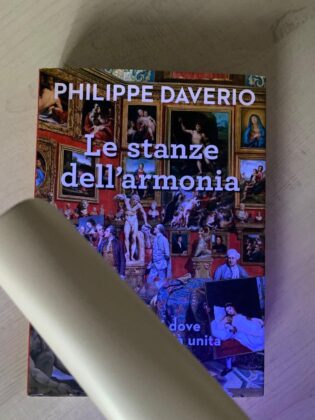 Useful for book covers …
Useful for book covers … 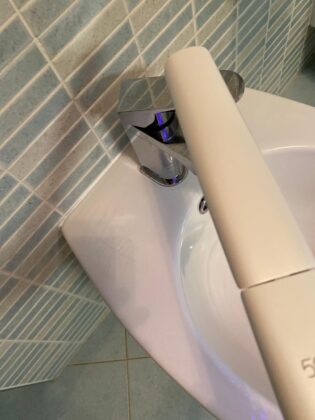 … and sanitary ware
… and sanitary ware
UVC wand, how it works
The wand, let's face it right away, must be handled with greater caution than is possible with the bag. This is due to the fact that here the LEDs (20 in all) are fully exposed.
In reality 59s has set up a series of safety systems, ranging from switching off by means of a gravity sensor when the device is turned upside down, to the particular way in which the wand is switched on (a very quick double click on the button), to a safe to unlock to turn on the lamp, ending with the buzzer that warns that the lamps are on.
Although it is therefore difficult to point the light towards the eyes seen, nothing would prevent a child or someone unaware of the problems that come from exposing the eyes to UV-C light from not trying to look directly at the LEDs. In addition, since it is a real lamp it is possible to irradiate the skin causing irritation and burns.
Having said all this, the use is very simple. The wand must first be recharged (for two or three hours) obtaining about fifty minutes of autonomy. Once turned on, it is used to sprinkle the surface we are interested in with light. The treatment involves a passage of 5-10 times, says the manufacturer, over the whole area at a distance of about two centimeters. After three minutes the wand switches off by itself.
It is important to note if the LEDs are on they do not turn off when the wand is closed. This can be considered a design flaw. There is a risk of consuming the battery or that, forgetting it on, a child opens it and finds it in active hand, despite all the precautions and safety systems that the manufacturer has put in place.
In conclusion
Both lamps we tried made a good overall impression on us. Apart from the certifications, which have absolute relevance when it comes to accessories with possible repercussions in terms of safety, however, they have a different destination to be taken into account in the purchase evaluation phase.
The bag is a household product with immediately intuitive and imaginable functions, useful for many purposes to the point of imagining being able to make a truly daily use of it if you have particular concerns about the spread of the virus.
Put on a piece of furniture it can be used to sterilize many objects that each of us is forced to handle constantly and let other people touch. It is also useful in an office or shop when dealing with situations with objects that are available to the public.
The wand, although engineered with precision (except for the detail of the failure to switch off when closing) seems to us to have a more restricted field of use. It is designed to be carried around, but there are few situations where the wand is preferable to the use of hand sanitizer or the use of gloves.
Rather, it seems more useful at home or in the office to sterilize large surfaces or objects that cannot be placed inside a bag. It is also a device to be handled with caution. For greater safety, it is also possible to buy glasses with UV-C filter which are also available on Amazon.
Prices and availability
The 59s bag can be purchased at the price of 118.99 euros on Amazon by clicking on this direct link and applying the discount code P55IT30OFF .
The 59s wand can be purchased at the price of 90.99 euros on Amazon by clicking on this direct link and applying the discount code X5IT30OFF01 .
We also recommend visiting the Amazon showcase of 5s to discover all the offers .








